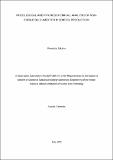Rheological and physicochemical analysis of non- edible oils used for biodiesel production
Abstract
The knowledge of the physicochemical and rheological flow characteristics of biodiesel
feedstock is used for quality control in production, storage and transportation processes.
Moreover, the knowledge is applied in redesigning and optimizing facilities that can be used
for manufacturing, storage and transportation of the fuel. Non-edible oils analysed in the
present study were Cashew Nut Shell Liquid (CNSL), Castor Oil (CO), croton megalocarpus
oil (CMO), podocarpus usambarensis oil (PUO) and Thevetia peruviana oil (TPO). Free fatty
acid, acid value, saponification value, peroxide value, iodine value, specific gravity and
moisture content were determined by following the recommended Association of Official
Analytical Chemists (AOAC) methods of analysing physicochemical characteristics.
Physicochemical results show that all the selected non-edible vegetable oils with an exception
of CNSL, do not require any further treatment. However, due to high Free Fatty Acid (FFA)
content in CNSL, direct biodiesel production from the feedstock would be a challenge hence
further treatment to reduce the acidity of the feedstock is essential. Rheological flow parameters
were analysed using VT-550 Thermo Haake Viscotester monitored by a Rheowin Job manager.
The pre-set parameters in the Viscotester were the shear rate and temperature. The shear rate
was increased uniformly from 5 𝑠−1 –100 𝑠−1 in 60 seconds at 30-60˚C. Regardless of the
analysis temperature, all oils exhibited Newtonian flow behavior, indicating that the viscosity
of the oil remained uniform at a constant temperature. The experimental data were fitted into
rheological models: Newton, Bingham, Oswald de Waele (power-law), and Herschel Bulkley
using Rheowin data evaluation software. The results revealed that Newton and Oswald de
Waele models were appropriate to represent the flow behaviour of the oils with the fit of R2 ≥
0.990.

